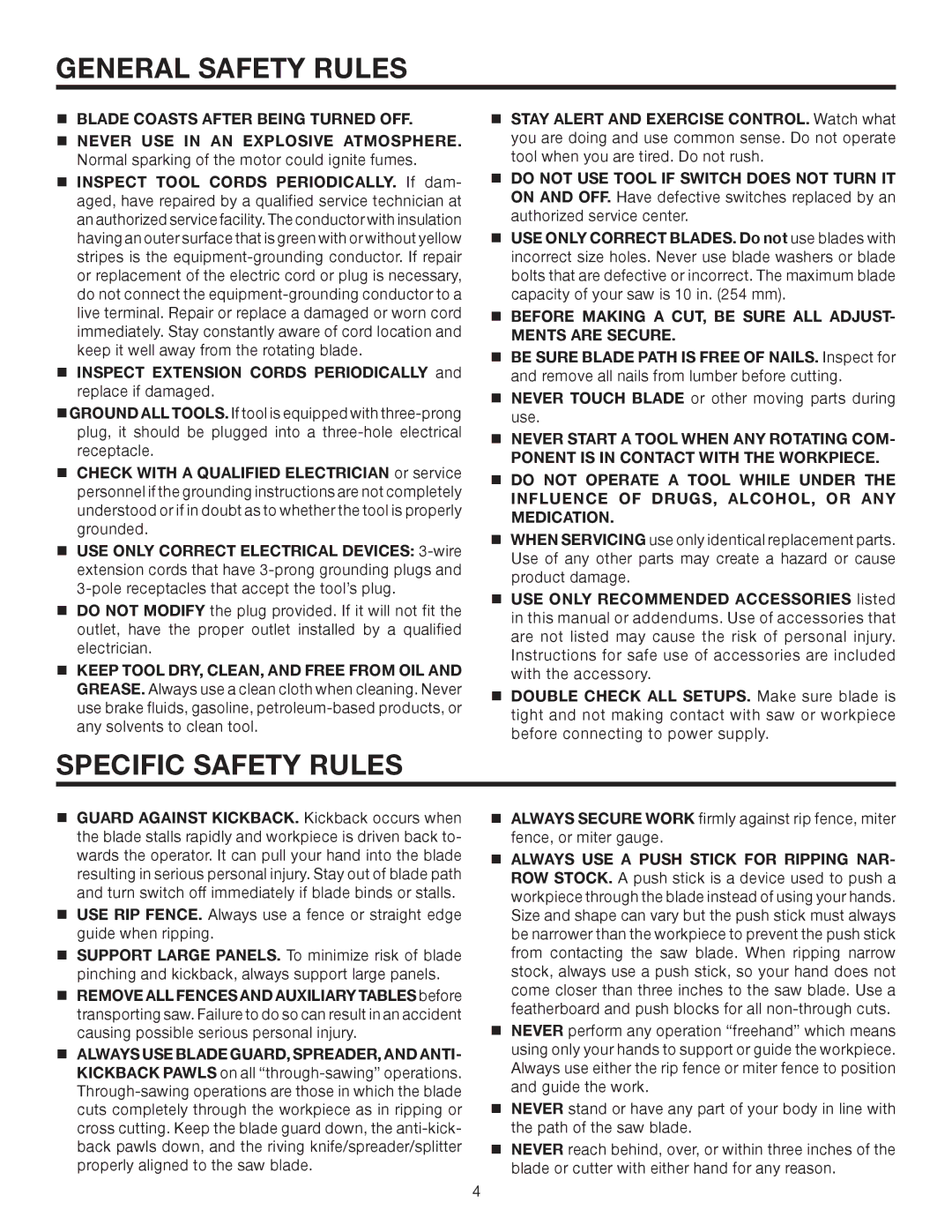
GENERAL SAFETY RULES
BLADE COASTS AFTER BEING TURNED OFF.
� NEVER USE IN AN EXPLOSIVE ATMOSPHERE. Normal sparking of the motor could ignite fumes.
�INSPECT TOOL CORDS PERIODICALLY. If dam- aged, have repaired by a qualified service technician at an authorized service facility. The conductor with insulation having an outer surface that is green with or without yellow stripes is the
�INSPECT EXTENSION CORDS PERIODICALLY and
replace if damaged.
� GROUND ALL TOOLS. If tool is equipped with
�CHECK WITH A QUALIFIED ELECTRICIAN or service personnel if the grounding instructions are not completely understood or if in doubt as to whether the tool is properly grounded.
� USE ONLY CORRECT ELECTRICAL DEVICES:
� DO NOT MODIFY the plug provided. If it will not fit the outlet, have the proper outlet installed by a qualified electrician.
� KEEP TOOL DRY, CLEAN, AND FREE FROM OIL AND GREASE. Always use a clean cloth when cleaning. Never use brake fluids, gasoline,
� STAY ALERT AND EXERCISE CONTROL. Watch what you are doing and use common sense. Do not operate tool when you are tired. Do not rush.
� DO NOT USE TOOL IF SWITCH DOES NOT TURN IT ON AND OFF. Have defective switches replaced by an authorized service center.
� USE ONLY CORRECT BLADES. Do not use blades with incorrect size holes. Never use blade washers or blade bolts that are defective or incorrect. The maximum blade capacity of your saw is 10 in. (254 mm).
� BEFORE MAKING A CUT, BE SURE ALL ADJUST-
MENTS ARE SECURE.
� BE SURE BLADE PATH IS FREE OF NAILS. Inspect for and remove all nails from lumber before cutting.
�NEVER TOUCH BLADE or other moving parts during use.
� NEVER START A TOOL WHEN ANY ROTATING COM-
PONENT IS IN CONTACT WITH THE WORKPIECE.
� DO NOT OPERATE A TOOL WHILE UNDER THE
INFLUENCE OF DRUGS, ALCOHOL, OR ANY MEDICATION.
� WHEN SERVICING use only identical replacement parts. Use of any other parts may create a hazard or cause product damage.
� USE ONLY RECOMMENDED ACCESSORIES listed in this manual or addendums. Use of accessories that are not listed may cause the risk of personal injury. Instructions for safe use of accessories are included with the accessory.
� DOUBLE CHECK ALL SETUPS. Make sure blade is tight and not making contact with saw or workpiece before connecting to power supply.
SPECIFIC SAFETY RULES
� GUARD AGAINST KICKBACK. Kickback occurs when the blade stalls rapidly and workpiece is driven back to- wards the operator. It can pull your hand into the blade resulting in serious personal injury. Stay out of blade path and turn switch off immediately if blade binds or stalls.
�� USE RIP FENCE. Always use a fence or straight edge guide when ripping.
� SUPPORT LARGE PANELS. To minimize risk of blade
pinching and kickback, always support large panels.
� REMOVE ALL FENCES AND AUXILIARY TABLESbefore transporting saw. Failure to do so can result in an accident causing possible serious personal injury.
� ALWAYS USE BLADE GUARD, SPREADER, AND ANTI- KICKBACK PAWLS on all
� ALWAYS SECURE WORK firmly against rip fence, miter fence, or miter gauge.
�ALWAYS USE A PUSH STICK FOR RIPPING NAR- ROW STOCK. A push stick is a device used to push a workpiece through the blade instead of using your hands. Size and shape can vary but the push stick must always be narrower than the workpiece to prevent the push stick from contacting the saw blade. When ripping narrow stock, always use a push stick, so your hand does not come closer than three inches to the saw blade. Use a featherboard and push blocks for all
� NEVER perform any operation “freehand” which means using only your hands to support or guide the workpiece. Always use either the rip fence or miter fence to position and guide the work.
�NEVER stand or have any part of your body in line with the path of the saw blade.
� NEVER reach behind, over, or within three inches of the blade or cutter with either hand for any reason.
4
